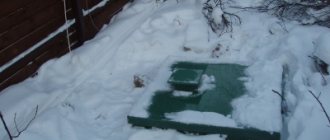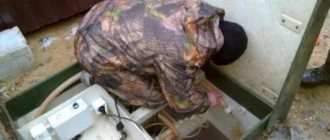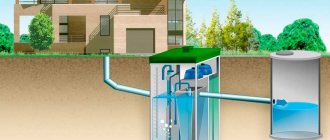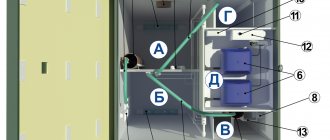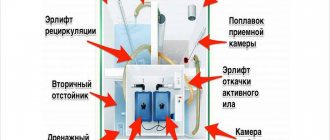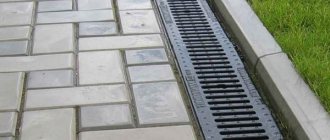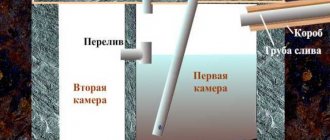Not all domestic wastewater treatment plants can operate in winter operating conditions. Modern models Topas, Tank, Astra 5, Topol, Tver and Unilos are able to remain operational until the ambient temperature drops to -10°C. After this, the septic tank will need to be mothballed for the winter.
Each model of wastewater treatment plant has specific features for preparing for the winter period. But the general principle of the work can be considered using the example of how a topas septic tank is preserved for the winter.
Insulation of the supply pipe
The supply pipe of the Topas septic tank, according to the installation diagram, is placed at an angle, the water in the main does not stagnate. However, there is a risk of gradual icing of the inner walls of the pipes, making it difficult for the next portions of waste to pass through. To avoid emergency situations, supply and connecting pipes are wrapped with mineral wool when laying. With a standard height for connecting pipes (32-52 cm), residents of private houses and dachas in Russia make do with a 5 cm layer of thermal insulation. The pipe insulation is also covered with a waterproofing compound.
Why do you need septic tank conservation?
Effective operation of a septic tank is only possible if the bacteria in it regularly receive the necessary portion of nutrients, which is fecal waste. In the absence of energy supply, the death of microorganisms may well occur.
If the installation of the sewerage station was carried out correctly, then even in extreme cold there is no threat to it. When the device is located below the freezing point of the soil, it will properly fulfill its purpose. A septic tank is just as necessary for residents in the winter as it is in the summer.
In order to prevent the formation of a crust of ice in the chambers of the device, you need to insulate the hatch.
For this purpose, a sealing material such as hay, straw, polystyrene foam or mineral wool is used. The opening time of the hatch should be minimized to prevent the liquid in the containers from freezing. You cannot completely drain the septic tank in winter. The soil is in constant motion. This is caused by temperature changes, changes in groundwater levels and melting snow. The septic tank is light in weight, which can cause it to be squeezed to the surface and cause sewer pipes to break. But removal of individual components, mechanisms and assemblies is necessary. Once on the surface, they can be torn apart by frozen water.
Conservation of Topas for the winter is carried out only in cases where the house or cottage will not be used for several months. Even if the sewer is used 1-2 times a week, this will be enough to maintain the vital activity of bacteria. In addition, warm drains will prevent the water in the chambers from freezing during severe frosts.
Selection of material for insulation VOC "Topas"
When choosing materials for insulating a septic tank, you should be guided by the durability of the device and take into account the operating conditions. The TOP 5 popular insulation materials will help you get rid of the need to constantly change insulating layers of straw and sawdust, which are prone to rotting:
Backfilling with expanded clay. The main advantages of expanded clay are its affordable price, high thermal insulation properties, resistance to moisture, adverse weather conditions, and durability. Granular material is poured into the space between the walls of the installation pit and the septic tank. The minimum laying layer is 20 cm.
Mineral and glass wool. The materials are resistant to aggressive environments, temperature changes, do not deform under mechanical load, retain their original characteristics for 2-3 years, but absorb moisture.
Expanded polystyrene. Thermal insulation can withstand sudden temperature changes and high humidity. Light weight and thickness of the material ensures ease of installation. The material is used to protect septic tanks, joints, and pipes.
Foamed polyurethane. Available in the form of sheets, blocks, panels, rolls. The material is strong, durable, and has antibacterial properties. The elasticity of the composition prevents the formation of cracks under mechanical stress.
Heating cable. The electric cable prevents freezing of Topas VOCs under harsh climatic conditions. Exudes a sufficient amount of heat for the normal functioning of bacteria. The cable requires mandatory protection from moisture, the sewer system requires complete insulation with bulk, rolled, sheet material.
Winter season
To understand how a septic tank works in winter, and whether you should worry about it, you should understand its structure:
- A septic tank is a wastewater treatment device made of concrete, stainless steel, fiberglass, polyethylene or other material buried in the yard;
- In all methods of treating domestic wastewater, two microbiological processes occur: anaerobic (from bacteria that do not require oxygen) and aerobic (from bacteria that require oxygen). Aerobic decomposition is usually preferred because aerobic bacteria break down organic matter (wastewater) at a rate much faster than anaerobic bacteria. Septic tanks use both processes;
- The tank must be buried at least two meters into the ground. At this level of the earth's surface, the ground temperature is never less than plus 5 degrees Celsius. The water does not freeze;
- The wastewater that leaves the house is usually warm, 20-40 degrees. As they pass through the pipes, they do not have time to cool down. This can also be seen from the ground located at the treatment station: the snow in this area melts faster than in others.
Do-it-yourself sewerage diagram in a private house
The listed aspects help the system survive the winter well.
For information. The condition of the septic tank is something that homeowners usually forget about until it is too late. To avoid problems in the future, it is better to follow the basic rules for operating a septic tank. But first, it’s worth learning about how the system works. This will help you avoid a lot of trouble and save money on system repairs in the future.
The principle of operation of a septic tank
Features of operating the Topas septic tank in winter
If the thermometer readings are above -20º, and more than 20% of the recommended volume of household wastewater enters the station, there is no need to insulate the septic tank for the winter. The Topas septic tank is made of durable polypropylene with low heat transfer capacity. Inside the housing there is its own source of heat energy - aerobic bacteria that generate heat during waste processing. The septic tank lid is additionally equipped with expanded polystyrene - reliable, modern insulation.
In areas with harsh climates, there is a high probability of the Topas septic tank freezing. The most sensitive to temperature reduction are the devices inside the tank - compressors and pumps. Noticeable cooling of the air provokes equipment overload and failure. It is worth taking measures to protect Topas VOCs from frost. If the thermometer readings are below -15º, do not open the unit lid unless absolutely necessary.
Why is preservation for the winter necessary?
The reason why you need to prepare your septic tank for winter is very simple. Most treatment facilities are installed above the freezing point of the soil. During severe frosts, pipes, containers and other important components filled with water freeze, which leads to breakdown of expensive equipment and equally cheap repair work to restore the system’s functionality.
To maintain the performance and integrity of the structure, preservation for the winter is required. Simply insulating a septic tank is ineffective. Only complete and competent conservation will help you fully prepare for the winter season.
Insulating the septic tank pipeline for the winter
To protect the pipeline system itself from freezing, the same materials are used as for insulating the main tanks of the wastewater treatment plant. The most common option is mineral wool covered with waterproofing. It is more convenient not to rely on the popularity of raw materials, but to purchase the same one that is used to protect the tank. This solution will help save on “trimmings”.
Some advise using polymers to create a kind of box around the pipe. This design prevents deformations and changes in the slope of the highway in the event of soil shrinkage.
Despite the abundance of factors that protect pipes from freezing, a heating cable is still placed in them. This is an additional guarantee of the absence of ice jams and other troubles in unforeseen circumstances.
As for the material of the pipes themselves, polymer specimens are most often used. They are lighter in weight, cheaper, do not rust and last longer than their counterparts. If you are concerned about their safety, place polymer elements in large asbestos-cement modifications. It is possible to reduce the risk of pipeline freezing by initially selecting a sufficient diameter and laying them with the least number of bends. The shorter the highway itself, the fewer problems there will be later.
Preservation of a septic tank for the winter
If you have the desire and opportunity to visit your suburban area at least once every two to three weeks during the frost period, conservation will not be required. Visits with such frequency are sufficient to maintain functioning. In case of absence for a longer period of time, it is worth suspending the operation of the cleaning station.
When purchasing an autonomous sewer system from the Kimberia company, you receive an accompanying package of documents, among which you can find instructions for preservation. Since the principle of this process is almost the same for most systems from various manufacturers, we will describe it briefly in the article (if the instructions are lost or a homemade modification is used):
- Disconnect the station from the power supply. As a rule, first turn off the toggle switch on the body, then inside the house;
- Free the cameras (including the stabilizer - using an airlift) from plastic, films, wood, cellophane;
- Disconnect the air compressor;
- Turn off the waste water discharge pump (if required by the design type);
- Check the occupancy of the cells. There should be at least 75% liquid left in them. If there appears to be less liquid, add regular water from a hose;
- If the cover was not insulated with polymer material during installation, do it yourself. If there are no materials, use improvised means - straw, rags, unnecessary warm clothing. Do not cover the lid with earth or sand.
Compliance with simple rules allows the station to survive the cold without serious losses in terms of bacteria and their vital activity. It is better to start the process before the onset of frost.
If the cold turns out to be stronger than expected, the liquid inside the tank may become covered with a fairly thick crust of ice. To prevent this layer from exerting strong pressure on the walls of the tank, make several floats from plastic bottles. The pressure will automatically transfer to them.
Reactivation of the septic tank
As soon as your visits to your country house become regular again, you can begin to re-open the septic tank. If you were in the process of pausing the work, starting it again will not be difficult. All familiar actions are played in reverse order:
- Remove the insulation from the lid;
- We take out the floats;
- Reconnect the compressor and pump;
- We connect the system to power.
Worried about bacterial activity? Flush the fermented milk product down the toilet or sink. A package of kefir is easier to find than specialized bacteria, but the essence does not change.
Avoid common mistakes. Firstly, you should not neglect the installation rules below the soil freezing level in a particular region. In the Moscow region it is about 1.5 - 2 meters. But it simply doesn’t make sense to deepen the system deep into the ground if the temperature in the area does not drop below 5 degrees. Secondly, do not empty the chambers completely before conservation. The housing will crack due to soil pressure, and the system will have to be completely replaced. At best, she will simply be pushed out of the ground.
The only way to protect an autonomous sewer system from low temperatures is to insulate the septic tank for the winter. Some are confident that if the container is installed at the optimal depth and all requirements are met, there is no need to be afraid of freezing. However, not all craftsmen follow the rules when installing equipment. And the climate in many regions is unpredictable. This requires reinsurance and insulation work. If the system freezes, it will stop working. This happens completely suddenly. The owners will not be able to use the toilet or tap. We'll have to wait for the craftsmen to defrost the sewer.
Frost can cause damage to used equipment. The pipes begin to crack. To repair them, you will have to dig through frozen soil. And this comes with additional costs. To avoid such expenses, it is better to insulate the septic tank for the winter in advance. Various insulation materials are used for this task. They are classified as inexpensive, budget or the most expensive.
Budget-friendly insulation of a septic tank for the winter
The price of insulation work scares off homeowners. They are afraid of expenses, trying to save money. Additional insulation for wastewater treatment plants can be expensive. However, experts advise using partial insulation and saving money. You can also completely insulate the septic tank for the winter. In the second case, the costs will not be too expensive. And the effect will exceed all expectations. Various building materials are used for such tasks. The most popular is expanded clay. It has a number of advantages.
First of all, it is necessary to note the biological neutrality of this insulation. Thanks to this, it has an extended service life. Expanded clay is not subject to rotting. It fits easily. Corresponding cavities are dug on the sides of the tank. Then insulation is poured there. It should be noted that the cost of expanded clay is low in comparison with existing analogues. It is better to carry out work when installing treatment equipment and pipelines. The expanded clay layer should be at least twenty cm.
Middle price segment
If your family budget allows, you can choose mineral wool. Basalt samples are used. Stone equivalents are also available. These insulation materials are not susceptible to biological effects. They do not freeze even in severe frosts. Mineral wool does not rot. Temperature changes are not dangerous for such insulation. It is available in rolls. Mineral wool briquettes are also sold. The latter option is more suitable for sewer stations. It is possible to increase moisture protection indicators. For this purpose, additional impregnation is used.
Glass wool is considered an interesting solution. It has the advantages listed above. Glass wool has increased moisture resistance. This insulation is not subject to deformation. It is impossible to break it. He is not afraid of stretching either. Mold and harmful microorganisms do not form on its surface. When performing insulation work, it is necessary to use personal protective equipment. Glass wool contains fine pollen. It may damage your eyes. Dust is also dangerous for the respiratory tract.
Expanded polystyrene also belongs to the middle price segment. Extruded foam is considered the best choice. Polymer compounds are used in production. They perfectly protect against low temperatures. The moisture protection indicator is quite high. Extruded foam is especially suitable for moving soils. Thanks to this, the sewerage structure is significantly strengthened. The reason for the strength lies in the numerous cells. They are filled with air. A special casing is used for pipelines. The main tank can be insulated with sheet foam.
Expensive insulation of a septic tank for the winter
To avoid freezing of drains in autonomous sewer systems, it is possible to use relatively expensive means. First of all, you need to highlight the use of electrical cables. This technology is very similar to the construction of so-called heated floors. Cables are wrapped around pipelines and tanks. Such insulation of the septic tank for the winter allows specialists to create the optimal temperature. Thanks to it, the danger of freezing will be prevented. However, you will have to supplement the electrical cables with insulation. The selected material must be sufficiently airtight. It is unacceptable to get used electrical wiring wet. This technology is characterized by its energy independence. The supply of electric current must be extremely stable. The wiring helps protect the entire station in cold temperatures. Therefore, the method is considered the most effective. It is used by many homeowners.
Foamed polyurethane is also considered an expensive insulation material. It is applied to surfaces using a sprayer. After hardening, a fairly dense layer is formed. It protects the system from moisture penetration. Foamed polyurethane is not susceptible to frost. It withstands various aggressive environments very well. However, it is better to use the summer months to apply such layers. With the onset of cold weather the task becomes more difficult. Therefore, you have to call in professionals who are well versed in the intricacies of installation work and will select the optimal composition.
Insulating a septic tank for the winter: pipes
Specialists pay special attention to the pipeline. The most vulnerable areas are the joints between pipelines and tanks. Severe frosts cause damage to such joints. There are two options for performing such thermal insulation. The first is called lining. Here it is permissible to use various insulation materials. You can use the spraying method. Expanded clay or mineral wool will also work. Often the joints are insulated with foam plastic. The second method is called special. He implies the use of the so-called shell. It is produced using insulating materials. First, they are installed on both sides of the pipeline. Then sealing is performed, thanks to which the insulation of the septic tank for the winter and the pipeline joints with the tank is performed at the highest level.
Additional ways to insulate a septic tank for the winter
When performing thermal insulation of sewer systems, it is important to adhere to specific rules. Only competent execution of work can guarantee the final effect. However, there are additional ways that can significantly simplify the insulation of a septic tank for the winter. To reliably protect the treatment equipment, it is better to begin insulation when installing the tank. This will allow you to easily approach each side of the tank. Insulation can also be placed under the bottom. After installing such a tank, access to the bottom will be closed. It is located below the freezing point. Therefore, it will be almost impossible to get to it.
When performing insulation work, care should be taken to ensure safety. To do this, you must completely turn off the power supply. This also applies to pumping equipment. The same should be done with compressors. If the tank is operational, care must be taken to fill it. The liquid should occupy at least 3/4 of the container. You should pay close attention to the empty part of the septic tank. The temperature in this part is quite low. Therefore, the equipment may freeze quickly. Depending on the selected thermal insulation material, its thickness is also selected. The minimum indicator is considered to be a 15-centimeter layer. And expanded clay should have a thickness of 20 centimeters. The protection of the pipeline must be taken care of even in the process of designing an autonomous sewer system. Stagnation of liquid inside is unacceptable. This may cause freezing. Therefore, the angle of inclination of the pipeline must be calculated correctly.
Seasonal residents of country houses should take care of maintaining the system during the winter months. This will help protect expensive equipment. And with the onset of spring, the sewerage system is being reconstructed. This way you can protect it from freezing and keep it in working condition.
What to do if the septic tank freezes?
Failure to insulate the septic tank in a timely manner for the winter can lead to freezing of the drains. A signal of such a phenomenon will be obstruction of the sewer system. Ice jams form in the system, preventing the drains from moving. As a result, water will rise in the sinks. And the owners won’t be able to flush the toilet. Such phenomena in the winter months indicate freezing of pipelines. In these cases, a household pump will help. It will help pump out the water. Then you can use different methods. By pouring boiling water, you can defrost ice plugs. However, it will take quite a long time to pour boiling water. At the same time, you will need to boil the water. You will have to work especially hard in case of severe frosts. Although, when choosing this method, you should be especially careful. Sudden temperature changes can damage the system. And this is fraught with accidents.
There are special solutions invented for defrosting sewer systems. They are made on the basis of salt. Various chemicals are also used. Each such component causes the ice to melt. Such a task should be entrusted exclusively to specialists. They understand the doses of dangerous chemicals and will ensure that the solution does not damage the surfaces. If the standards are violated, corrosion of the pipes will occur. As a result, a leak will appear. You will have to make expensive repairs. Defrosting can be done by installing an electrical wire. It will cost quite a lot. In addition, such defrosting will last a long time. Although the technology is considered the safest for the pipeline. Warming up of frozen sections occurs slowly and gradually. As a result, the patency of the system is completely restored.
Insulating the septic tank for the winter is a mandatory procedure. But it is better to entrust such a matter to professionals. Only they can choose the appropriate materials and techniques. Attempting to complete such a task on your own can lead to irreparable results. Even the slightest violation of technology can cause destructive processes, the consequences of which will be disastrous. And these are extra costs for materials and specialist services. Therefore, it is better to initially contact a specialized company that provides the services of experienced craftsmen who are well versed in the specifics of thermal insulation techniques. Only they can guarantee the quality of the work performed with documentation and deliver a perfectly functioning system that will not be affected by frost or temperature changes.
Resumption of work
To resume normal operation of the system, after the winter period all procedures are performed in the reverse order. For high-quality operation, it will be necessary to add bacteria to the septic tank, for which kefir and sour cream are perfect. This simple manipulation will allow your system to get into working condition faster.
Our specialists know everything about winter maintenance of Topas cleaning stations. Call to clarify details or place an order for septic tank preservation.
Stages of preserving a septic tank Astra, Topas, BioDeka with your own hands:
- Disconnection from the power supply and shutdown of the compressor;
- Pumping water from the bottom of the septic tank to 30-45 cm;
- Immersion of bottles with sand into each chamber;
- Insulating the septic tank cover.
The first stage of septic tank conservation: turning off the compressor
First, you need to turn off and remove the compressor from the septic tank. This is necessary so that the compressor does not once again go through many cycles of freezing and thawing; moreover, it can simply be stolen, since it is during the winter period of the year that burglars most often rob houses.
The second stage of septic tank conservation: pumping out water
Then you need to pump out the top 30-45 cm of water, approximately to the depth of soil freezing. Under no circumstances should you pump out the septic tank completely - this will lead to disastrous consequences! This is necessary so that the water in the upper part of the septic tank does not turn into ice and does not break the walls of the septic tank. Water must be pumped out from all chambers: receiving chamber, dual chamber and sludge collector. It is better to pump water from the bottom of the station in order to pump out all the heavy particles at the same time. By pumping out the water from the bottom of the station, it will be easier and simpler for you to maintain the septic tank next season. It is best to use a drainage pump to pump out water. If there is no drainage pump, then this is not a problem; you can use an ordinary bucket. This method will take longer and you will not be able to pump out water from the bottom, but the physical meaning of the procedure will still be fulfilled, because the main thing is to lower the water level by 30-50 cm from the ground level.
The third stage of septic tank conservation: immersion of bottles
Next, we immerse bottles of sand in each chamber of the septic tank, where they will float so that ice does not form in the upper part of the septic tank. To do this, we need 4 bottles of 1.5-2 liters, which are 20-25% filled with sand. We tie a rope 1 - 1.5 meters long to the neck and lower these 4 bottles into each of the chambers of the septic tank. We tie the rope to the transverse pipes, which provide rigidity to the station body. Bottles must float freely throughout the entire area of the septic tank chamber!
The fourth stage of septic tank conservation: insulation
Insulation of a septic tank is carried out as follows: first, insulation (PENOPLEX) or heat-retaining fabric is laid, then polyethylene so that the fabric does not get wet and does not rot. The polyethylene is pressed on top to prevent it from being blown away; logs can be used as clamps. Insulating the septic tank lid helps keep the station warm, since most of the septic tank is underground, and therefore warmer than the environment. As you can see, conservation of septic tanks Astra, Topas, BioDeka can be done with your own hands, it will not take much of your time or effort!
